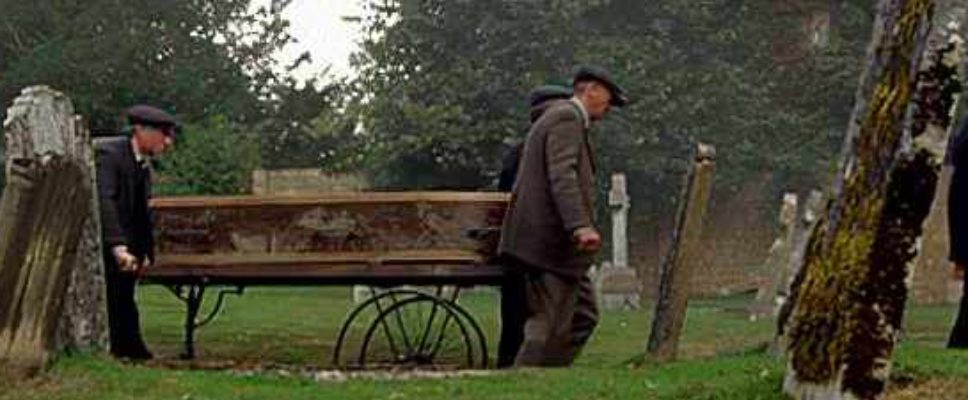Teresa Reviews “Three Act Tragedy” (2010)
Teresa reviews “Three Act Tragedy” (2010) and finds it a theatrical take on murders most foul.
Fidelity to text: 3 1/2 poisoned cocktails
 Be forewarned: This movie follows the British version with a different motivation than the U.S. version. Mr. Satterthwaite gets disappeared, and Poirot’s part is beefed up.
Be forewarned: This movie follows the British version with a different motivation than the U.S. version. Mr. Satterthwaite gets disappeared, and Poirot’s part is beefed up.
Quality of movie on its own: 4 poisoned cocktails
 It’s theatrical, showy, and deliberately stagy like a play. Go with the flow, and you’ll enjoy it. If you don’t, the artificiality will make you crazy.
It’s theatrical, showy, and deliberately stagy like a play. Go with the flow, and you’ll enjoy it. If you don’t, the artificiality will make you crazy.
Read more of Teresa’s Agatha Christie movie reviews at Peschel Press.
Also, follow Teresa’s discussion of these movies on her podcast.
 If you think the film is melodramatic and contrived, you’re right! Which is just how it should be. The novel (not all versions do this) comes with a frontispiece:
If you think the film is melodramatic and contrived, you’re right! Which is just how it should be. The novel (not all versions do this) comes with a frontispiece:
Directed by
Sir Charles Cartwright
Assistant Directors
Mr. Satterthwaite
Miss Hermione (Egg) Lytton Gore
Clothes by
Ambrosine, Ltd.
Illumination by
Hercule Poirot
The novel is broken into three sections, like a stage play.
Act One: Suspicion
Rev. Babbington dies under strange circumstances
Act Two: Certainty
Dr. Strange dies but this time, it’s murder
Act Three: Discovery
Poirot connects the crimes and solves the case.
The producers did some rewriting. The obvious bit is removing Mr. Satterthwaite. The novel is essentially told from his point of view as he interacts with Sir Charles and Egg to solve a death that no one else, including Poirot, believes was murder. Sir Charles is adamant from the first day that it had to be murder and he — enjoying the chance to play a real detective instead of pretending to be one — slowly persuades everyone else to his point of view.
With Mr. Satterthwaite gone, Poirot takes center stage as he didn’t in the book. He’s in most of the scenes, including one where it’s hard to believe he’d be Johnny-on-the-spot, following Miss Milray from busy, bustling London all the way to Cornwall to an ivy-shrouded tower to keep her from destroying the mad scientist laboratory used to distill nicotine from rose spray.
So, three acts. We open with Sir Charles on a lovely sailboat in the waters off Cornwall.
 He’s dressed in a movie version of a yachtsman’s outfit, much too clean and well-dressed to be handling the rigging. He’s probably playacting so it’s a good thing he’s got Egg, local girl, along to manage the lines and navigate the choppy waters. This sets us up for his sad, unrequited longing for Egg, a luscious damsel young enough to be his daughter, or granddaughter if you’re feeling mean.
He’s dressed in a movie version of a yachtsman’s outfit, much too clean and well-dressed to be handling the rigging. He’s probably playacting so it’s a good thing he’s got Egg, local girl, along to manage the lines and navigate the choppy waters. This sets us up for his sad, unrequited longing for Egg, a luscious damsel young enough to be his daughter, or granddaughter if you’re feeling mean.
I had trouble with this throughout the film. Not Sir Charles panting after Egg, but him acting as though it’s impossible to win her love. Powerful men always lust after sweet young things, particularly as they get older. By snagging her, she demonstrates they’ve still got it. Wealth, status, and power are time-tested aphrodisiacs.

So as you’re watching, remember that Sir Charles knows he’s manipulating pretty, naïve Egg. Don’t make the mistake of thinking he expects to be rejected. It’s part of his script. He’ll get his happy ever after with the wife he’s been postponing for decades and the charming family to bless his old age.
After a day of sailing, Sir Charles hosts a gathering of the principal suspects plus Poirot. The party ends tragically after the Rev. Babbington dies after sipping a cocktail identical to everyone else’s. Sir Charles springs into action, following a script that says a sudden death at a dinner party must be murder. Poirot, an old hand at this business, demurs.
Act two begins. Dr. Strange is hosting a fancy dinner at his estate.


On to act three. Poirot can’t figure out why and how Rev. Babbington was poisoned. There’s no connection between the good reverend and Dr. Strange. As Captain Dacres tells Egg, nobody poisons saintly country vicars. They’re harmless. Doctors, on the other hand, know harmful secrets. They do terrible things. They have victims. There’s always a reason to kill a doctor.
Poirot races about on trains up and down England.


Then, dénouement. A very theatrical one, taking place on stage at the dress rehearsal for Miss Will’s new play. Poirot takes center stage and reveals all.
If you’ve read the American version of the novel or seen the Peter Ustinov film, know this: the ending was not substantially rewritten. There are two versions of this novel. The American version (followed by Ustinov’s film) has one motive. The British version here has a different reason for murder.
You could make the case that Sir Charles was just as crazy in the British version as in the American. After all, he’s a famous actor. He’s a professional liar. He fakes sincerity all the time. If he believes something is true, then so will the audience. So why not believe he can get away with murder and bigamy and win sweet, naïve Egg and his happy ever after? That’s what happens in the movies.
Read more of Teresa’s Agatha Christie movie reviews at Peschel Press.

